 W
WThe 2nd Lancers is one of the oldest and a highly decorated armoured regiment of the Indian Army. The regiment was formed by the amalgamation of two of the oldest regiments of the Bengal Army – the 2nd Royal Lancers and the 4th Cavalry.
 W
WThe 6th Lancers is an armoured regiment of the Pakistan Army. Previously, it was known as the 6th Duke of Connaught's Own Lancers , and was a regular cavalry regiment in the British Indian Army. It was formed in 1921 by amalgamation of the 13th Duke of Connaught's Lancers and the 16th Cavalry. The regiment and its predecessors have seen active service on the North West Frontier, in Egypt during 1882, in China during the Boxer Rebellion, the two World Wars and the Indo-Pakistani War of 1965. On the Partition of India in 1947, the regiment was allotted to the Pakistan Army, where it remains in service today.
 W
WThe 8th Punjab Regiment was a regiment of the British Indian Army from 1922 to 1947. It was transferred to Pakistan Army on Partition of India in 1947 and merged with the Baluch Regiment in 1956.
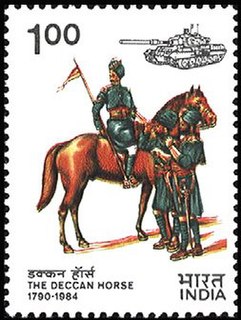 W
WThe Deccan Horse or 9 Horse is one of the oldest and most decorated armoured regiments of the Indian Army. The The Royal Deccan Horse , which was a regular cavalry regiment of the British Indian Army was formed from the amalgamation of two regiments after World War I. They saw service from the Mutiny of 1857 up to and including World War II.
 W
WThe 10th Baluch or Baluch Regiment was a regiment of the British Indian Army from 1922 to 1947. After the independence, it was transferred to the Pakistan Army. In 1956, it was amalgamated with the 8th Punjab and Bahawalpur Regiments. During more than a hundred years of military service, the 10th Baluch Regiment acquired a distinguished record amongst the regiments of the British Indian Army. Its list of honours and awards includes four Victoria Crosses.
 W
WThe 11th Cavalry , is an armoured regiment of the Pakistan Army. It was previously known as the 11th Prince Albert Victor's Own Cavalry and was a regular cavalry regiment of the old British Indian Army. It was formed in 1921 by the amalgamation of the 21st Prince Albert Victor’s Own Cavalry and the 23rd Cavalry.
 W
WThe 11th Sikh Regiment was an infantry regiment of the British Indian Army. They could trace their origins to 1922, when after World War I the Indian government reformed the army moving from single battalion regiments to multi battalion regiments. The regiment was formed from the:1st Battalion – 14th King George's Own Ferozepore Sikhs 2nd Battalion – 15th Ludhiana Sikhs 3rd Battalion – 45th Rattray's Sikhs 4th Battalion – 36th Sikhs 5th Battalion – 47th Sikhs 10th Training Battalion – 35th Sikhs
 W
WThe 12th Frontier Force Regiment was formed in 1922 as part of the British Indian Army. It consisted of five regular battalions; numbered 1 to 5 and the 10th (Training) Battalion. During the Second World War a further ten battalions were raised. In 1945, the prenominal "12th" was dropped when the British Indian Army dispensed with prenominal numbering of its regiments. After the independence in 1947, it was formed into the Frontier Force Regiment, part of the army of Pakistan.
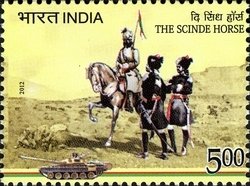 W
WThe 14 Horse is an armoured regiment in the Armoured Corps of the Indian Army. The regiment, known before independence as the 14th Prince of Wales's Own Scinde Horse was a regular cavalry regiment of the Bombay Army, and later the British Indian Army.
 W
WThe 14th Punjab Regiment was a regiment of the British Indian Army from 1922 to 1947. It was transferred to the Pakistan Army on independence in 1947, and amalgamated with the 1st, 15th and 16th Punjab Regiments in 1956, to form the Punjab Regiment.
 W
WThe 15th Punjab Regiment was a regiment of the British Indian Army from 1922 to 1947. It was transferred to Pakistan Army on independence in 1947, and amalgamated with the 1st, 14th and 16th Punjab Regiments in 1956 to form the Punjab Regiment.
 W
WThe 16th Light Cavalry is a regiment of the Armoured Corps, a primary combat arm of the Indian Army. Prior to India gaining independence from the British in 1947, it was a regular cavalry regiment of the British Indian Army. It was formed in 1776 and is the oldest armoured regiment raised in India. The 16th Light Cavalry saw service in a number of conflicts ranging from the Second Anglo-Mysore War in 1781 to World War II. It has a number of battle honours including "Punjab 1965" earned during the Indo-Pakistani War of 1965.
 W
WThe 16th Punjab Regiment was an infantry regiment of the British Indian Army from 1922 to 1947. Upon the Partition of India, it was transferred to the newly-raised Pakistan Army. It ceased to exist in this form in 1956, when it was amalgamated with the 1st, 14th and 15th Punjab regiments to form the Punjab Regiment, an existing infantry regiment of the Pakistan Army.
 W
WThe 24th Hazara Mountain Battery was an artillery battery of the British Indian Army.
 W
WThe 30th Punjabis were an infantry regiment of the British Indian Army. It was raised in 1857, as the 22nd Regiment of Punjab Infantry. It was designated as the 30th Punjabis in 1903 and became 1st Battalion 16th Punjab Regiment in 1922. In 1947, it was allocated to the Pakistan Army, where it continues to exist as 13th Battalion The Punjab Regiment.
 W
WThe 33rd Indian Mountain Regiment, Royal Indian Artillery was an artillery regiment of the Indian Army during World War II, which fought in the Burma Campaign and South-East Asia.
 W
W45 Cavalry is an armoured regiment in the Armoured Corps of the Indian Army. The regiment distinguished itself in operations during the 1971 Indo-Pakistan War winning one Maha Vir Chakra.
 W
WThe Assam Rifles is the oldest paramilitary force and belongs to the Assam regiment of Indian Army, dating back to 1835 under the British Raj, raised under the name Cachar Levy. The present name of "Assam Rifles" has been used since 1917. Over the course of its history, the Assam Rifles have served in a number of roles, conflicts and theatres including World War I, where they served in Europe and the Middle East, and World War II, where they served mainly in Burma. After the Chinese annexation of Tibet, the Assam Rifles were tasked with manning the Tibet border of Assam Himalayan region. They were also instrumental in maintaining law and order in the tribal Arunachal Pradesh.
 W
WThe Bengal Engineer Group (BEG) is a military engineering regiment in the Corps of Engineers of the Indian Army. The unit was originally part of the Bengal Army of the East India Company's Bengal Presidency, and subsequently part of the British Indian Army during the British Raj. The Bengal Sappers are stationed at Roorkee Cantonment in Roorkee, Uttarakhand.
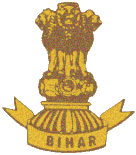 W
WThe Bihar Regiment is an Indian Army infantry regiment. It traces its origins back to the British Indian Army. The Bihar Regiment was formed in 1941 by regularising the 11th (Territorial) Battalion, the 19th Hyderabad Regiment, and raising new battalions. The Bihar Regimental Centre (BRC) is located at Danapur Cantonment, Patna, the second oldest cantonment of India. INS Vikramaditya, the Indian Navy's largest ship and its sole aircraft carrier is affiliated to the Bihar Regiment, Indian Army's highly-decorated and battle-hardened unit. The regiment also distinguishes itself by having the highest number of Rashtriya Rifles battalions among all regiments of the Indian Army.
 W
WThe Central India Horse was a regular cavalry regiment of the British Indian Army and is presently part of the Indian Army Armoured Corps.
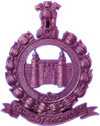 W
WThe Indian Army Corps of Engineers provides combat engineering support, develops infrastructure for armed forces and other defence organisations and maintains connectivity along the borders, besides helping the civil authorities during natural disasters. College of Military Engineering, Pune (CME) is the premier technical and tactical training institution of the Indian Army Corps of Engineers.
 W
WThe Corps of Guides was a regiment of the British Indian Army made up of British officers and Indian enlisted soldiers to serve on the North West Frontier. As originally raised in 1846, The Guides consisted of infantry and cavalry. It evolved through the 20th century to become the Guides Cavalry and Guides Infantry. Once independence was granted to India and after the partition, The Guides were given over to Pakistan and became part of the Pakistan Army with all ranks including officers being recruited solely from Pakistan.
 W
WThe Governor General's Bodyguard was a cavalry regiment of the British Indian Army. The regiment was, in effect, the Indian equivalent of the Household Cavalry of the British Army.
 W
WThe Grenadiers is an infantry regiment of the Indian Army, formerly part of the Bombay Army and later the pre-independence British Indian Army, when the regiment was known as the 4th Bombay Grenadiers. It has distinguished itself during the two world wars and also since the Independence of India. The regiment has won many battle honours and gallantry awards, and is considered to be one of India's most decorated regiments with three Param Vir Chakra awardees in three different conflicts.
 W
WThe Guides Cavalry is an armoured regiment of the Pakistan Army which was raised in 1846 as The Corps of Guides. During more than a hundred and fifty years of military service, the regiment has earned the reputation of one of the most renowned military units in the world.
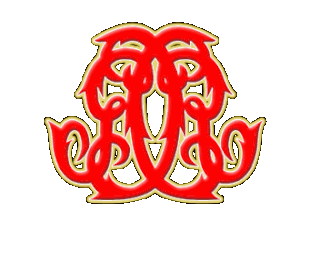 W
WThe Guides Infantry, or 2nd Battalion (Guides) The Frontier Force Regiment, is an infantry battalion of the Pakistan Army. It was raised in 1846 as part of the famous Corps of Guides.
 W
WThe Kumaon Regiment is an infantry regiment of the Indian Army. The regiment traces its origins to the 18th century and has fought in every major campaign of the British Indian Army and the Indian Army, including the two world wars, and is one of the highly decorated regiments.
 W
WMadras Engineer Group (MEG), informally known as the Madras Sappers, is an engineer group of the Corps of Engineers of the Indian Army. The Madras Sappers draw their origin from the erstwhile Madras Presidency army of the British Raj. This regiment has its HQ in Bengaluru. The Madras Sappers are the oldest of the three groups of the Corps of Engineers.
 W
WThe Multan Regiment was a regiment of the British Indian Army that saw action in the Battle of Ghazni, during the First Afghan War in 1839. The regiment was based in the city of Multan, where it was first raised. Since the independence of Pakistan in 1947, it has been part of the Pakistan Army.